This post contains affiliate links. We may get paid an affiliate commission if you buy something or take an action after clicking one of the links on this web page.

I went to the SHOT (Shooting Hunting Outdoors Trade) Show 2020 and the Las Vegas Custom Knife Show 2020 and saw literally thousands of knives. Because of the internet in general (and Instagram in particular) most of them looked familiar, but I had never seen 99% of them in person. I buy pretty much everything except fresh vegetables online, so I never really know how big knives are or how they feel until they arrive in my mailbox, so it was really neat to be able to see everything in person and ask questions.
If you missed it, here is a link to part one of our SHOT Show 2020 Coverage. My mission with these two SHOT articles is to not only give my fellow knife nerds a heads up on what’s in store for us in 2020, but since I actually got my hands on them, I’ll do my best to describe how they feel. I apologize for my bad photography- I’m going to do a much better job next year!
MEDFORD KNIFE & TOOL
Nosferatu OTS Auto and Flipper
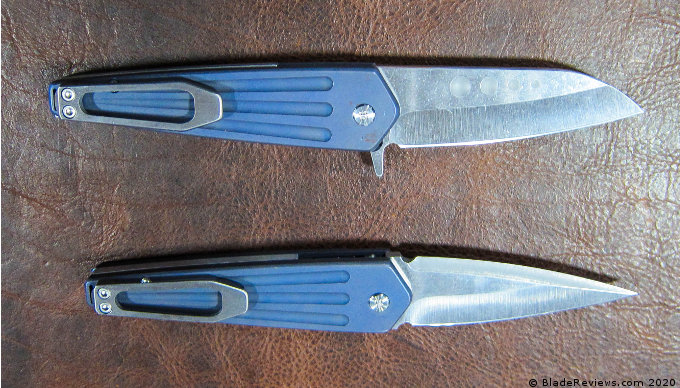
Pretty much every Medford Knife is in permanent beast mode, and the Nosferatu series of knives are no exception. When I slid off the safety and pressed the lock/go! button, a long, asymmetrical dagger with a false top edge swung out with a nice thwack sound. The flipper version with its sheepsfoot blade was nice and all, but it’s docile looking in comparison to the auto. Both knives use a round plunge lock button near the pivot to unlock and manually close the blade. The flipper’s blade swings freely when the lock button is depressed, so if you want to wrist flick a $650 knife, you can. The auto is $25 more at an MSRP of $675, and both are due out in April 2020.
On paper, their specs sound fairly normal: 3.5” S35VN blade, overall length of 8.4”, and .19” blade and handle thickness. Did the thickness number sound a little high? To put it in perspective, I have an old DPX Gear HEST-F, which has a comically thick blade- it’s .19” like the Nosferatu. Every knife person in the world (other than me) seems to have a heavy duty Spyderco Paramilitary 2 or 3, and their blade thickness is only .15”. Even the legendarily beefy old ZT 0300 series (commonly remembered as the NCIS Jethro Gibbs knife) maxed out at .16”.
My point is these things are THICK. And heavy. I really dug the simple linear design, the coffin-shaped pocket clips (Nosferatu means vampire in Romanian folklore) and the sharp-looking but round-feeling chamfering of the handles. I had never held a Medford knife before visiting their booth, and after putting down the Nosferatu and trying out some other Medford knives, it became very clear to me that the Nosferatu knives are the only ones with corners that are chamfered for your pleasure. The signature Medford style is big square-edged chunks of titanium and steel, and my soft, city-boy hands much preferred the slightly rounded feel of the Nosferatu.
Praetorian Slim Folder
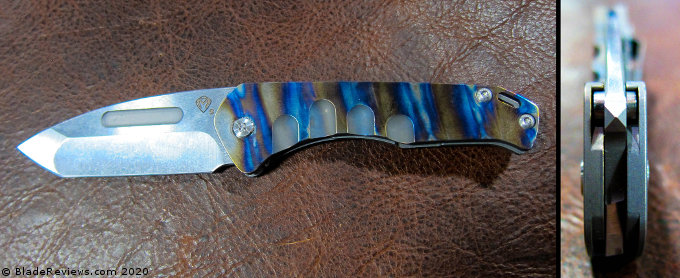
Another new for 2020 knife, the Praetorian slim’s 3.25” blade is made from shockingly thin .125” blade stock but still has that square, slightly uncomfortable Medford feel. Two unique features of the Praetorian Slim are its thin, straight, kind of un-Medford-ey pocket clip (not pictured) and its glassbreaker (detail picture above). The full-size Praetorian knives have a hardened D2 steel glass breaker pommel, but the Slim has a little glassbreaker pyramid machined into the base of the blade. The MSRP is $525.
MICROTECH
Dirac OTF auto

Microtech had a table at the Las Vegas Custom Knife Show, and that’s where I found my newest purchase, the Dirac, soon to be reviewed on this website. My Microtech Dirac has a 2.875” blade of M390 steel and a 4” handle, not counting the length of the glassbreaker.
The Dirac and its larger version, the Dirac Delta, are different from any previous Microtech switchblades in that the sliding switch is on the flat side of the handle, not the spine. The switch placement gives the Dirac a couple of advantages. First, it allows the knife to be vertically symmetrical, which looks good. Second, it allows the switch to be noticeably wider and less tall top-to-bottom than spine-mounted Microtech switches. This gives my thumb much more surface area to apply pressure on the spring loaded switch, which feels good.
Iconic Karambit OTS auto
Here is a Link to the Iconic Karambit so you can check it out. I was so busy trying to figure out the little tiny safety switch on the spine of this new for 2020 auto karambit that I didn’t get a picture. I would ordinarily ask Microtech for a picture for this write-up, but I’m kinda talking smack about this one so I’m not going to ask.
At Microtech’s Las Vegas Custom Knife Show booth, I watched three people besides myself unsuccessfully try to close the Iconic, and just put it back on the table with the blade out for the Microtech reps to close. I’m sure it’s just a matter of practice, but for the first time ever I found a Microtech I don’t like.
PRO-TECH
Malibu Flipper
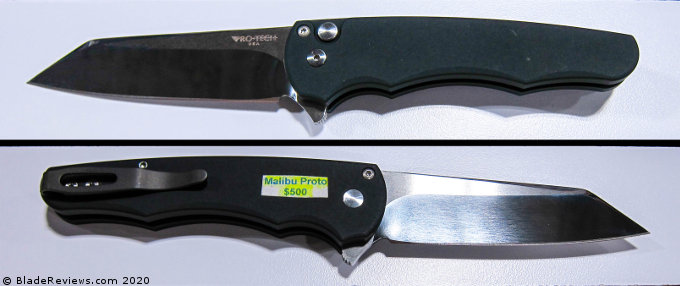
Pro-Tech’s newest knife is the Malibu, and although its smooth aluminum handles and hardware components have a standard Pro-Tech out-the-side auto look about them, Pro-Tech has swerved a little out of its lane with the Malibu. As far as I know, the Malibu is only the second flipper that they’ve made, and it’s their first knife with this blade shape. Pro-Tech calls it a reverse tanto blade. The Malibu will also be available with Pro-Tech’s first sheepsfoot blade (not pictured.) According to Pro-Tech’s Instagram page, the Malibu is going to further depart from the Pro-Tech norm by having CPM 20CV blade steel instead of their usual 154CM.
The Malibu’s 3.25” blade was on ball bearings and flipped open smoothly. To close the knife, I pressed the appropriately-recessed button lock, which had what I feel to be an appropriate amount of spring pressure to keep the button from being unintentionally pressed during appropriate use. I would characterize this knife as a light-to-medium duty tool. The blade is .11” thick and the shape is designed for utility rather than stabbing. I personally do very little stabbing in my day-to-day knife usage, and I prefer blade shapes like these that don’t require much wrist-bending to get the tip of the blade onto the packing tape of a box. I didn’t find the looks of this knife particularly exciting- its kind of average in length, width, and pocket clip, but Pro-Tech’s big thing is making lots of interesting cosmetic variations of their knives, and I expect the Malibu to be no exception.
REATE
T3000 and T3500 Flippers
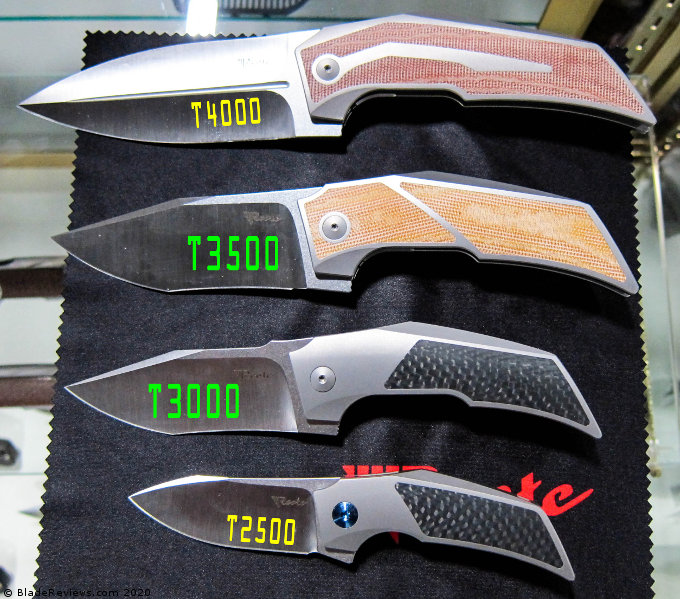
The final two knives in designer Tashi Bharucha’s four knife “T” series are on their way to a 2020 release. BladeReviews has already reviewed the first two releases- Dan did the T2500 review in April of 2019, and I reviewed the T4000 in October. Their names are based on blade length, and the 3” T3000 ($330 MSRP) and the 3.5” T3500 ($360 for the micarta handle inlay version (pictured) and $370 for carbon fiber) should be released between April and June 2020. All four knives have titanium handles and M390 blades, and the T3000 and T3500 samples I handled had the excellent fit and finish I’ve come to take for granted from Reate. Their flipper action was on ball bearings and the big blades locked firmly into place. None of the knives in the series are particularly thick, but the tall handles filled my hand enough to get a solid grip.
I’m a huge fan of Tashi Bharucha’s work. I’ve got a Tashi Bharucha Heatseeker flipper (made by Reate, sold exclusively by drop.com) in my pocket right now. The Heatseeker, like the entire T series, is an elegant, aggressive knife that prioritizes style over user comfort. All that means in practice is that the T3000 and T3500 had a couple of hotspots in the form of somewhat sharp flipper tabs and pokey pocket clips. These are not manufacturing mistakes, they’re design choices, and I didn’t mind at all because the knives are so cool looking.
SOG
Ultra XR Folder
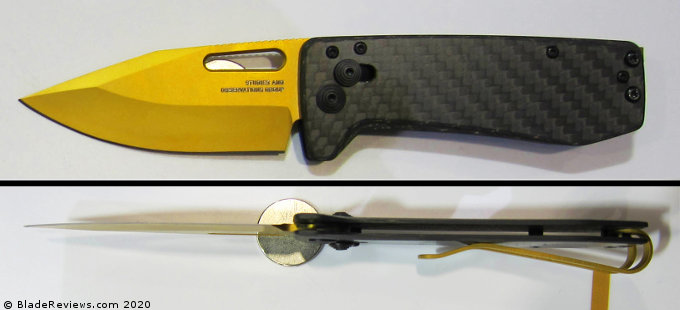
First of all, I learned that SOG is an acronym for Studies and Observations Group, which makes no sense to me as the name of a knife company (I think spotting scopes or notepads or ghillie suits would be more sensible products from the Studies and Observations Group) but SOG is owning it by engraving “STUDIES AND OBSERVATIONS GROUP” on every new knife blade I saw. Nonetheless, they had some interesting new knives at SHOT, starting with the Ultra XR. It was absolutely remarkable how thin and light this knife was. The clip is thicker than the blade and handles combined. The specs: 2.8” blade, S35VN steel colored gold with a titanium nitride finish, carbon fiber handles, titanium pocket clip, and an XR (slidey-button) lock. The Ultra XR weighs 1.2 oz., which is less than half the weight of a Spyderco Delica, which also has a 2.8” blade.
My hands-on studies and observations of the Ultra XR revealed that opening the blade with the long oval thumb hole was pretty much effortless. The SOG rep thought that it was running on bearings instead of washers, and it certainly felt like it, although it’s so thin I don’t know how they fit bearings in there. Regarding its sturdiness, I didn’t try to crush it in my hand or spine whack it with the 4.6 oz WE Knife Co. Scoppio I had in my pocket, but the Ultra XR felt relatively sturdy for something so thin and light. MSRP is $139, and its release should be before fall 2020.
Aegis AT Folder
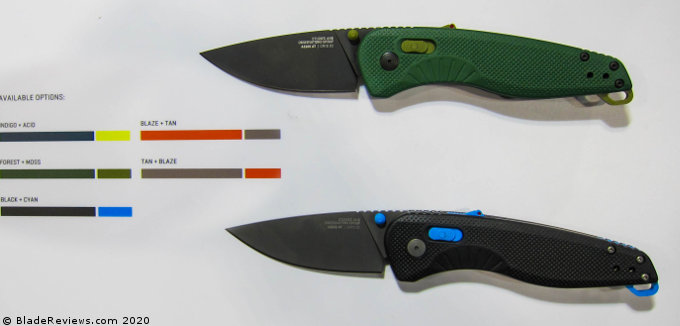
The Aegis isn’t new- Dan reviewed the SOG Aegis for BladeReviews in 2011. I bought an Aegis Mini in 2012, and we both have nothing but praise for them. 2020 brings a few updates, some of which I like. I like the upgrade to D2 blade steel, I like that the pocket clip no longer has the “SOG” acronym stamped into it (the full company name is on the blade like all the other 2020 SOG’s), and I like the jaunty new color combos. My dislikes can be summed up with this quote from The Graduate: “I want to say one word to you. Just one word. Plastics.” The new lanyard loop is plastic. The new spine-mounted safety lock is plastic. The AT-XR (slidey-button) lock button is now plastic- the part you must apply pressure to every time you close the knife is plastic, instead of aluminum like on the older version.
I opened and closed the Aegis maybe ten times and its assisted-opening 3.7” blade snapped open very quickly and locked open just fine. However the spine mounted safety felt somewhat vague and flimsy, and the plastic lock button didn’t feel like it would immediately break or deform, but my brief studies and observations of the SOG Aegis left me with the impression that it’s a great looking knife that I wouldn’t trust without a lot of hands-on testing.
SPYDERCO
Bombshell Folder – Flash Batch
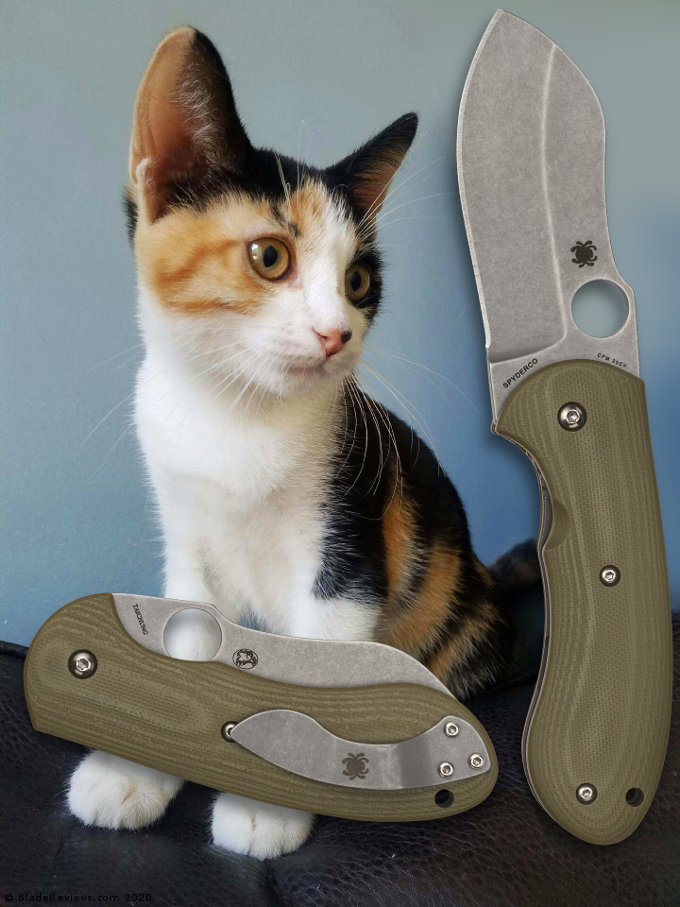
Spyderco let me handle the not-yet released Bombshell folder, but wouldn’t let me photograph it. Instead they gave me a web catalog jpeg of it with no background, so I layered it over a picture of my kitten, Buttercup. Knife/cat size is not to scale.
The Spyderco Bombshell is the production version of designer Michael Burch’s custom Bombshell. It felt heavier than your average Spyderco, and very well made. The thick G10 handles had far more of a 3-D rounded feel than most Spyderco knives, and despite its short (4.04”) handle length, it filled my hand nicely. Its tall 2.98” CPM 20CV blade reminds me of designer Jens Anso’s work, and the pocket clip looks similar to the clip on Michael Burch’s now-discontinued Spyderco Chubby. It’s a Spyderco “Flash Batch” limited limited to 1,200 pieces. I don’t have a release date, but I do know the street price should be $280.
2020 Spyderco Sprint Run Knives
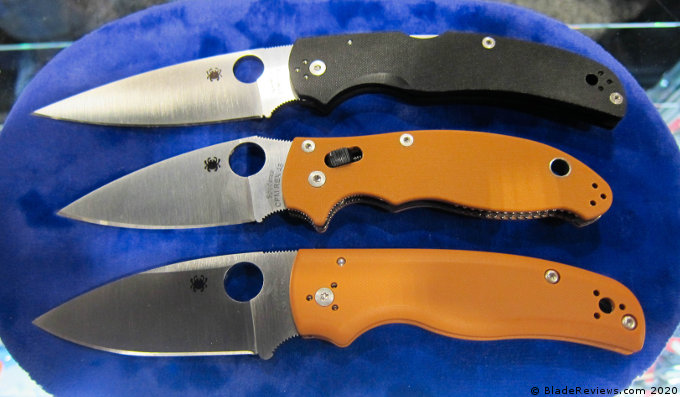
I also got a look at some of the 2020 Spyderco Sprint run knives, which all have CPM REX45 steel blades and burnt orange colored handles. Pictured from top to bottom are the Native Chef (without the upcoming orange scales), the Manix 2, and the Shaman, which were the only three of eight upcoming Sprint Run knives Spyderco had on hand at SHOT Show. Collectors love the Sprint Run because by definition it’s a one-time limited run in a non-standard steel/color combo. I don’t go bananas for Spyderco like many, many people do, but they all seemed very nice.
STRIDER KNIVES
DB-L Fixed Blade
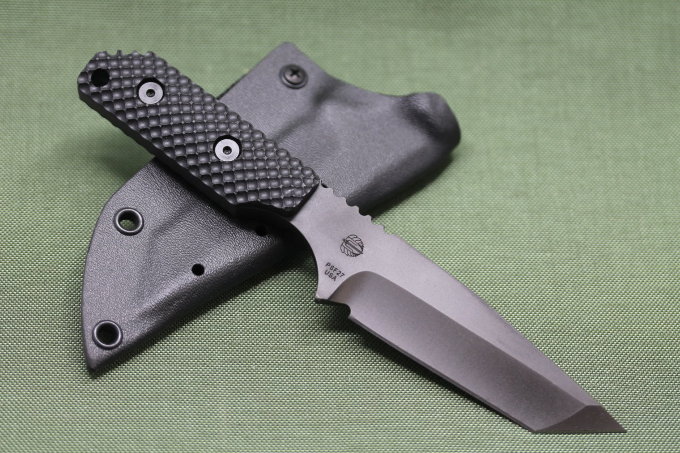
The Strider Knives DB-L isn’t new- it’s at least 10 years old, but it was new to me when I got to check one out at the Las Vegas Custom Knife Show. The DB-L has a 3.9” blade of PSF 27 steel (similar to D2 steel) with a thickness of .19, just like the manly Medford blades mentioned earlier in this article. The handle length is just over 4”, which would ordinarily be long enough for most people to get all their fingers around the grip, but there’s a pretty big finger choil and the G10 grips don’t go far enough forward to allow a four finger grip.
The reason I’m mentioning this in an article focused on new knives is that ever since I handled the CRKT Minimalist Cleaver on the first day of SHOT Show (see the Most Interesting Knives of SHOT Show 2020 Part One). I’ve been fascinated with how knife designers can give the user a solid grip with a handle only long enough for a three finger grip. CRKT’s solution was to make the handle so thin and contoured that it squeezed into the space between the bottom of my fingers and my palm.
When I picked up the Strider DB-L, I understood Strider used a different strategy: a rather thick handle. The shape and diameter of the DB-L’s handle permitted a three finger death grip on the knife in both a normal and reverse grip. The extremely aggressive texture of the G10 “Gunner Grip” handles made by VZ Grips also helped. After relaxing my three-finger death grip, my hands retained the pressed-in Gunner grip texture for a minute or so. As an owner of some VZ handgun grips, I can tell you from personal experience that the grips would rather take some skin with them than slip out of your hand.
After taking a look at VZgrips.com just now, I’m filled with regret that I didn’t think to visit the VZ Grips booth at the SHOT Show- in addition to making grips for Strider Knives, VZ makes a line of absolutely insane G10 daggers. And not just non-metallic (non-metal detector triggering) daggers- they make sharpened cylindrical G10 stabbers disguised as No. 2 pencils and something called the Punch Ripper that’s too horrible to describe. I’m going to kick my COVID stay-at-home blues by getting one of those stabbin’ pencils!
VIPER KNIVES
Katla Folder
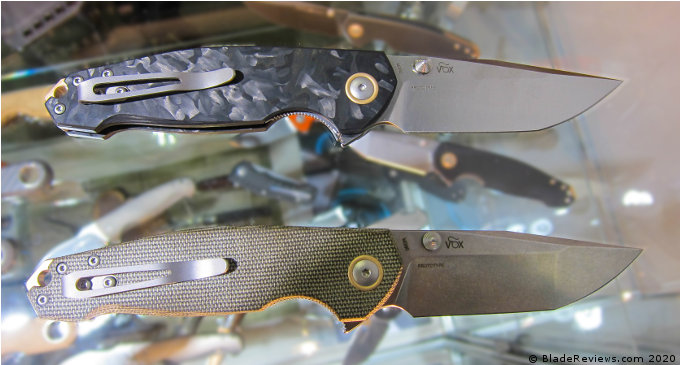
The Katla is a thumbstud-opening folder designed by Jesper Voxnaes. The blade is 3.23” of Bohler M390 steel and it will come in several handle and blade finish variations- pictured above are the carbon fiber version and the micarta version, which will have MSRP’s of $208 and $174. There are also some versions (not pictured) that have an interesting organic melty looking machined texture near the pivot and lanyard hole.
The action on the two prototypes I was able to handle was very smooth, and the lockup was solid. I was unable to determine if the knives were pivoting on washers or bearings. The Viper rep made a point of telling me that the pivot collars and backspacers were bronze, but to me they looked very copper-y. Later I did a little research and discovered that the bronze looked like copper because bronze is mostly copper- who knew? Blacksmiths since 3500 BC knew, and now we all do.
WE KNIFE CO.
Gava Flipper
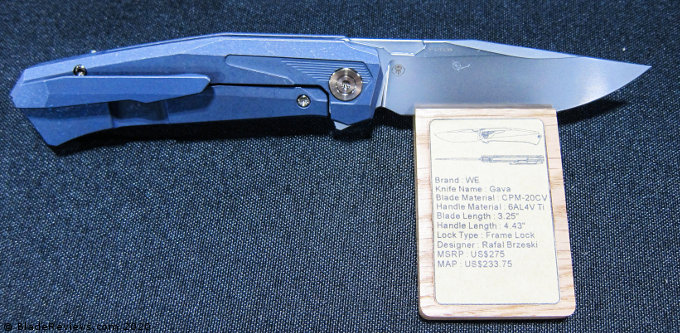
The WE Knife Co. Gava is a scaled-down production version of the custom Gava framelock by BRR Knives of Legnica, Poland. The WE Gava has a 3.25” CPM 20CV blade (1/2 inch shorter than the custom version), titanium handles, and a bearing-driven flipper action.
In the hand, the Gava was typical WE Knife Co quality, which is high. It felt light and tight and flipped briskly. Judging by photos I’ve found online, the WE Gava I handled at SHOT appears to be a pretty faithful rendition of the custom Gava. For me, the major enjoyment of this knife would be in the long contemplation of its thousand neat little machined details. A BRR custom Gava (if you can find one) costs no less than $1,000 USD. I often find it difficult to understand the reason for the high prices of many custom knives, but I’ve done a bit of research on this one, and have definitely figured out the reason for the high price of custom BRR Knives: supply and demand.
People in BRR Knives home town of Legnica, Poland, have been panic buying edged weapons ever since the Mongol invasion of Legnica in 1241 AD. It’s obviously panic buying in case the descendants of Genghis Khan try it again. The WE Knife Gava has a very reasonable MSRP of $275.
Mini Buster Flipper
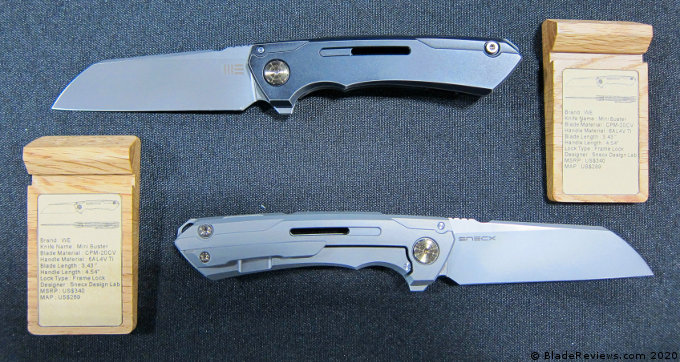
I had a nerd-gasm when I saw the Mini Buster on the WE Knife table. I’m a huge fan of the Mini Buster’s creator Snecx Tan. I find his design language to be simple and elegant, and the Mini Buster is my most anticipated knife release of 2020. Until now, Snecx has only personally made a handful of knives in his small workshop in Indonesia, and only released two of his designs to be produced by other companies: the Terra folder, produced by Custom Knife Factory, and the (full size) Buster, produced by Jake Hoback Knives. The WE Mini Buster is a framelock design with a 3.43” blade of CPM-20CV steel (vs the 4” M390-bladed JHK Buster), and titanium handles in either a light or dark stonewashed finish. The WE Mini Buster is less overbuilt than the Hoback version and is visually way more Snecx-y.
Handling the Mini Buster, my prevailing thought was that there are a lot of titanium framelock flipper knives out there, but the weight, balance, flipping action, and overall vibe of the Mini Buster have taken it to the top of the framelock flipper genre. Snecx said on his Instagram page that his goal is to make a folding knife as timeless as the Chris Reeve Knives Sebenza. The Mini Buster is not quite that, but it’s clearly a step in the process. He documents that process pretty thoroughly on Instagram, where I’ve been watching the evolution of Snecx’s next knife, the Vision. Snecx has invented an entirely new locking mechanism for the Vision, and that knife definitely has the potential to stand toe to toe with the Sebenza. The release date of the Vision is unknown, but the WE Mini Buster (MSRP of $340) is slated for an April 2020 release. I’m going to buy a Mini Buster tout suite and review it here on BladeReviews.com.
And as an extra treat, here’s a picture of the legendary Arsenal RS-1 knife/gun.
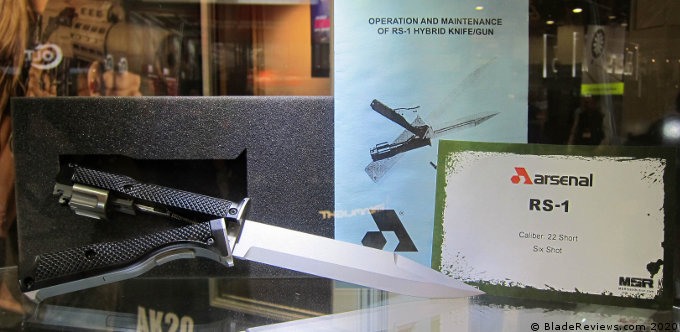
It’s a Rambo knife attached to a six shot revolver chambered in the not-at-all-powerful caliber 22 Short. It’s made by Arsenal Firearms of Russia, it’s $2,500 USD, its target demographic is Russian mob bosses, and it wins Most Interesting Knife of SHOT Show 2020. Thank you for reading!
Leave a Reply